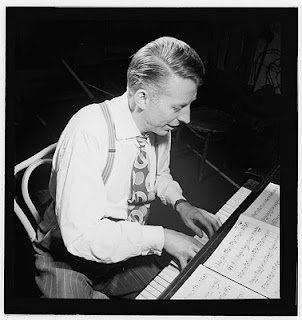 |
Portrait of Stan Kenton, New York, N.Y.Kenton, Stan Stan Kenton Orchestra Jazz musicians--1940-1950. Conductors (Music)--1940-1950. Pianists--1940-1950 |
Introduction to Jazz
Step 1 - Blue Notes
Blue Notes are typically the lowered 3rd, 7th and sometimes 5th degree of a chord. The jazz sound begins by using blue notes.
Example:
C7 = E to Bb to E
F7 = Eb to A to Eb
G7 = F to B to F
Step 2 - The Jazz Chord
Create a jazz chord sound by using blue notes. Play each chord several times.
C7 = C/BbE
F = F/ AEb
G7 = G/BF
C7 = C/BbE
Step 3 - The Jazz Feel
Rhythms in jazz are most important. They are what makes jazz swing.
Practice the following examples several times, and experiment with a "loose" or "jazz" feel. These jazz notes, chords and rhythms are combined in Straight Ahead.
C7 = C/BbE then play (r.h. single notes D#, E, C, D)
F7 = F/AEb then play (r.h. single notes Gb, G, F, Eb, C)
G7 = G/BF then play (r.h. single notes C, C#, D)
C7 = C/BbE, then C/BbG then play (r.h. single notes D#, E, G, E)
F7 = F/AEb, then C/AEb, then play (l.h. single notes Ab, Eb, D, C)
C7 = C/BbE, then B/Eb, then Bb/D, then A/C
G7 = G/BF, then Ab/Eb to C, then G/D then C/C... ending C/DF#A
I'm reading this very cool book called teach Yourself Jazz by Bert Konowitz. The credit to this article goes to him.
"Jazz washes away the dust of every day life." -- Art Blakey





